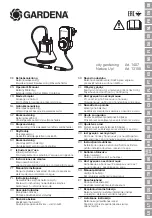
ENGLISH
GB
GB
5. For the best mowing results, the engine should
always be driven at full throttle.
STOPPING THE ENGINE
The engine may be very warm immedi-
ately after it is shut off. Do not touch the
silencer, cylinder or cooling flanges. This
can cause burn injuries.
Release the Start/Stop loop
G
(fig. 9) to stop the
engine.
If the start/stop loop ceases to work,
stop the engine by removing the spark
plug cable from the spark plug.
Immediately take the lawn mower to an
authorised workshop for repair.
REAR WHEEL DRIVE (*)
Engage the drive by pressing the clutch loop
J
towards the handle. Disengage the drive by releas-
ing the clutch loop
J
(fig. 9).
SPEED (*)
Do not touch the variator control when
the engine is not running. This can dam-
age the operation of the variator.
Set to a suitable speed by moving the variator con-
trol to one of the 4 positions (fig. 10).
The various positions have the following speeds:
Position
:
approx. 2.8 km/h
Position 2:
approx. 3.1 km/h
Position 3:
approx. 3.6 km/h
Position
:
approx. 4.5 km/h
CUTTING HEIGHT
Do not set the cutting height so low that
the blade(s) come into contact with
uneven ground.
The mower has single-lever control for adjusting
the cutting height. Pull the lever out, and set the
cutting height to one of the nine positions best
suited to your lawn (fig. 11).
MAINTENANCE
IMPORTANT – Regular, careful maintenance is
essential for keeping the safety level and origi-
nal performance of the machine unchanged in
time.
Wear strong working gloves during any cleaning,
maintenance or adjustment operation on the
machine.
Should it be necessary to access the lower part,
only tilt the machine from the side shown in the
engine handbook; following the relative instruc-
tions.
CLEANING
Carefully clean the machines with water after each
cut; remove the grass debris and mud accumulat-
ed inside the chassis to avoid their drying and thus
making the next start-up difficult.
The paintwork on the inside of the chassis may
peel off in time due to the abrasive action of the cut
grass; in this case, intervene promptly by touching
up the paintwork using a rustproof paint to prevent
the formation of rust that would lead to corrosion of
the metal.
Remove the transmission casing by removing the
screws
S
(fig. 12) and clean around the transmis-
sion (*) and drive belts (*) with a brush or com-
pressed air once or twice a year.
Once every season, the drive wheels (*) should be
cleaned internally. Remove both wheels. Clean the
gear wheel and the wheel gear rim of grass and dirt
using a brush or compressed air (fig. 13).
LUBRICATING DRIVE SHAFT (*)
Once per season, the wedge on the drive shaft
should be greased. Remove the wheel (wheel cap,
screw and washer). Then remove the circlip and
washer so that the gear wheel can be removed
from the shaft. Lubricate the wedge with universal
grease.
Reinstall the wedge (the wedge is installed differ-
ently on the right and left side, fig. 14-15). Install
the gear wheel so that the «L» faces out on the left
side and the «R» faces out on the right side
(machine viewed from the rear).
BATTERY (*)
In normal use during the season, the battery is
charged by the engine. If the engine cannot be
started with the ignition key, it may be because the
battery is 'dead'.
Dismantle the battery by opening the battery cover,
disconnecting the terminal on the engine and
removing the battery (fig. 16). Connect the battery
charger (provided) to the battery, then connect the
charger to a wall socket and charge for 24 hours
(fig. 17).
35


























